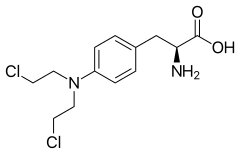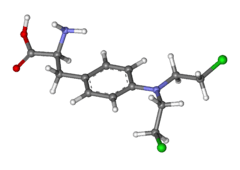Melphalan
 | |
 | |
| Clinical data | |
|---|---|
| Trade names | Alkeran |
| AHFS/Drugs.com | Monograph |
| MedlinePlus | a682220 |
| Routes of administration | Oral (tablets), intravenous |
| ATC code | |
| Legal status | |
| Legal status |
|
| Pharmacokinetic data | |
| Bioavailability | 25–89% (oral) |
| Metabolism | Hydrolysis to inactive metabolites |
| Biological half-life | 1.5 ± 0.8 hours |
| Excretion | Renal (IV: 5.8–21.3%) |
| Identifiers | |
| |
| Synonyms | (2S)-2-amino-3-{4-[bis(2-chloroethyl)amino]phenyl}propanoic acid |
| CAS Number | |
| PubChem CID | |
| IUPHAR/BPS | |
| DrugBank | |
| ChemSpider | |
| UNII | |
| KEGG | |
| ChEBI | |
| ChEMBL | |
| ECHA InfoCard | 100.005.207 |
| Chemical and physical data | |
| Formula | C13H18Cl2N2O2 |
| Molar mass | 305.2 g/mol |
| 3D model (JSmol) | |
| |
| |
| (verify) | |
Melphalan (trade name Alkeran, in former USSR also known as Sarcolysin) is a chemotherapy drug belonging to the class of nitrogen mustard alkylating agents.
An alkylating agent adds an alkyl group (CnH2n+1) to DNA. It attaches the alkyl group to the guanine base of DNA, at the number 7 nitrogen atom of the imidazole ring.
Otherwise known as L-phenylalanine mustard, or L-PAM, melphalan is a phenylalanine derivative of mechlorethamine.
Mechanism of action
Melphalan chemically alters through alkylation of the DNA nucleotide guanine, and causes linkages between strands of DNA. This chemical alteration inhibits DNA synthesis and RNA synthesis, functions necessary for cells to survive. These changes cause cytotoxicity in both dividing and non-dividing tumor cells.[1]
Uses
It is used to treat multiple myeloma,[2] ovarian cancer, AL amyloidosis, and occasionally malignant melanoma.
The agent was first investigated as a possible drug for use in melanoma, it was not found to be effective.
On March 15, 2016 it was approved by the U.S. FDA under the trade name Evomela for:
- use as a high-dose conditioning treatment prior to hematopoietic progenitor (stem) cell transplantation in multiple myeloma (MM) patients
- the palliative treatment of MM patients for whom oral therapy is not appropriate[3]
Melphalan is currently being used to treat ocular retinoblastoma, a pediatric solid tumor. This is accomplished via transarterial catheter based slow pulsed infusion into the ophthalmic artery.[4]
Administration
Oral or intravenous; dosing varies by purpose and route of administration as well as patient weight.
Melphalan Prescribing Information: Alkeran[5]
Melphalan Patient Information: MedlinePlus[6]
Melphalan Material Safety Data Sheet (MSDS): Sequoia Research Products[7]
Side effects
Common side effects include:
- Nausea and vomiting, and oral ulceration.
- Bone marrow suppression, including
- Decreased white blood cell count causing increased risk of infection
- Decreased platelet count causing increased risk of bleeding
Less common side effects include:
- Severe allergic reactions
- Pulmonary fibrosis (scarring of lung tissue) including fatal outcomes (usually only with prolonged use)
- Hair loss
- Interstitial pneumonitis
- Rash
- Itching
- Irreversible bone marrow failure due to melphalan not being withdrawn early enough
- Cardiac arrest
Synthesis
Another amino acid-like drug is the antineoplastic agent melphalan. Tumor cells spend less time in resting phases than normal cells so at any given time, they are more likely to be metabolically active than most normal host cells. The rationale behind incorporating an alkylating function in a molecule resembling a primary cellular metabolite was to get a greater safety margin by fooling tumor cells into taking up the toxin preferentially.

p-Nitrophenyl-alanine (1) was converted to its phthalimide by heating with phthalic anhydride, and this was converted to its ethyl ester (2). Catalytic hydrogenation produced the corresponding aniline. Heating in acid with oxirane, followed by treatment with phosphorus oxychloride provided the bischloride, and removal of the protecting groups by heating in hydrochloric acid gave melphalan (3).
See also
- Melflufen, an experimental prodrug of melphalan
References
- ↑ "Melphalan". National Cancer Institute. Retrieved 4 August 2014.
- ↑ Facon T, Mary JY, Hulin C, et al. (October 2007). "Melphalan and prednisone plus thalidomide versus melphalan and prednisone alone or reduced-intensity autologous stem cell transplantation in elderly patients with multiple myeloma (IFM 99-06): a randomised trial". Lancet. 370 (9594): 1209–18. PMID 17920916. doi:10.1016/S0140-6736(07)61537-2.
- ↑ "Evomela (melphalan) for Injection, for Intravenous Use. Full Prescribing Information". Spectrum Pharmaceuticals, Inc. Irvine, CA 92618. Retrieved 17 March 2016.
- ↑ Gobin YP, Dunkel IJ, Marr BP, et al. (Jun 2011). "Intra-arterial chemotherapy for the management of retinoblastoma: four-year experience". Arch Ophthalmol. 129 (6): 732–7. PMID 21320950. doi:10.1001/archophthalmol.2011.5.
- ↑ celgene.com
- ↑ nlm.nih.gov
- ↑ seqchem.com
- ↑ Bergel, F.; Stock, J. A. (1954). "Cyto-active amino-acid and peptide derivatives. Part I. Substituted phenylalanines". Journal of the Chemical Society (Resumed): 2409. doi:10.1039/JR9540002409.
- ↑ Bergel, F.; Burnop, V. C. E.; Stock, J. A. (1955). "Cyto-active amino-acids and peptides. Part II. Resolution of para-substituted phenylalanines and synthesis of p-di-(2-chloroethyl)amino-DL-phenyl[?-14C]alanine". Journal of the Chemical Society (Resumed): 1223. doi:10.1039/JR9550001223.
- ↑ Larionov, L.F.; Khokhlov, A.S.; Shkodinskaja, E.N.; Vasina, O.S.; Troosheikina, V.I.; Novikova, M.A. (1955). "STUDIES ON THE ANTI-TUMOUR ACTIVITY OF p-DI-(2-CHLOROETHYL) AMINOPHENYLALANINE (SARCOLYSINE)". The Lancet. 266 (6882): 169. doi:10.1016/S0140-6736(55)92736-7.